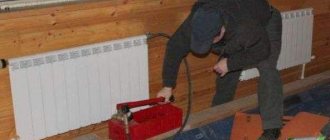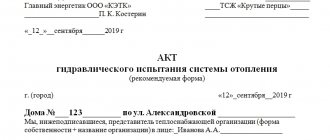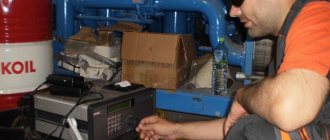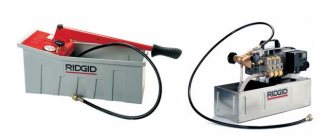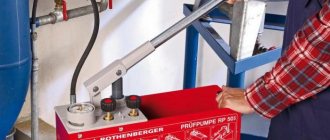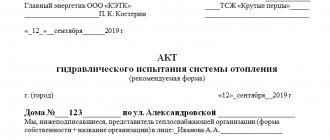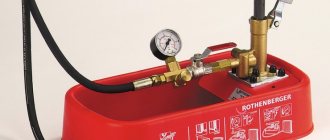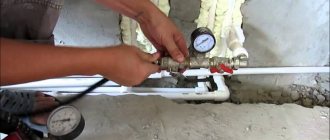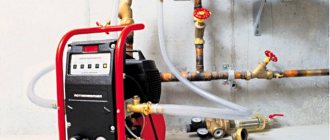The essence and types of crimping
Nowadays heating is most often carried out by a “water circuit” system.
At the same time, heated water circulates through the works, imparting its thermal energy to the premises. Leaks are unacceptable; the pipeline must be completely sealed for normal operation. Pressure testing specifically creates a larger volume in the pipe than normal. When this is done using air, it is called pneumatic pressing.
When using water, then hydropressing. The latter method is considered safer and therefore more popular. For this reason, an example of hydropressing is provided as a form.
When testing, it is recommended not to exceed the pressure inside the pipe more than 15 MPa. If we are talking about raising pressure with water, then there are limitations. The maximum possible pressure should not exceed the normal operating pressure by more than 30%.
In multi-storey buildings they resort to pneumatic pressure testing if the pipes are very old and there is a risk of flooding. But then there is a level of risk and all residents must be notified of the tests being carried out.
The work process is simple, but multi-stage. The algorithm looks like this:
- The necessary materials and equipment are being prepared.
- Draining the liquid that was previously in the heating system.
- Uploading a new one.
- Create the highest possible test pressure.
- Taking control measurements after 10 minutes.
- Flushing, adjusting the heating system to normal pressure levels inside.
- Documentation of work performed, generation of reports and acts.
But this is how the list of procedures looks only if there are no “thin spots” in the heating system and, accordingly, the tightness in it is not broken. If the pressure drops quickly and does not hold, then the system needs repair work. In such a situation, the specialist performs the necessary actions (replacing the pipe, sealing connections, cleaning, etc.), and then begins crimping from the very beginning. Only a heating system that has passed the test is allowed into the heating season.
Important nuance! Pressure testing should be carried out after cleaning and flushing the pipes. Otherwise, salt and other deposits inside them can mask possible external damage and breakthroughs.
If there are deposits of about 1 cm on the inner surface, then this reduces the overall heat transfer and efficiency by 15 percent or more of the overall indicators. To document the cleaning, a special report is also drawn up.
Regulatory rules
SNiP contains technological diagrams that take into account the features of work in accordance with safety regulations, as well as the necessary equipment. Any hydraulic testing of the heating system must be carried out in accordance with this document.
Important. Before hydraulic tests, the system must be flushed. It can be carried out in various ways and its task is to remove deposits and scale from the inner walls of pipes. It is produced with special solutions and a compressor.
The following oxides can be observed as deposits in pipelines:
- Gland;
- Magnesium;
- Calcium;
- Copper;
- Zinc;
- Sulfur.
Components of the heating system pressure test report
At the top left is information about the organization that carried out the inspection. Ideally, there should be a signature for approval by the chief power engineer of the heating supply organization.
The top right should contain subscriber information. That is, about who is the client and consumer of heating services. This could be a partnership of residents of a particular house, any organization that occupies the building, the owner of a private house, etc.
It is important to provide names and other information accurately and in detail. In this case the address is required
The main part of the act states:
- City.
- The date of signing the act (and the pressure test itself).
- Heat supply organization: its form of ownership, name, full name of the representative.
- Which of the subscriber's representatives accepted the heating system after the test: full name, position.
- To what indicators the pressure in the system was raised is indicated in kgf/cm2.
- To what indicators did it drop after 10 minutes following the shutdown (the units of measurement here are also kgf/cm2, it is also permissible to measure it in mPa if accurate data on this matter is available).
- Whether the system passed or failed the test (the person completing the form needs to highlight the correct option).
The final part consists of the signatures and seals (if any) of the representatives:
- Subscriber.
- Heat supply organization.
- Service organization.
In general, the act of pressure testing the heating system is a convenient primary document, for filling out which the heat supply organization is responsible.
Test report for ladders, racks and stepladders
Inspection and testing of racks, ladders and stepladders is carried out at least once every six or twelve months (depending on the object being tested and the material from which it is made).
Tests and checks for safe operation can be carried out by specialized organizations from outside or a commission specially created at the enterprise. At the same time, its members must be trained; an occupational safety or fire safety engineer is usually appointed as the chairman of the commission.
As a result of the diagnosis, the commission draws up a report; it is better to document it with the date of the inspection. The header indicates the name of the document, date and place of compilation. It is also important to indicate the details of the organization, list the members of the commission: their positions and full names.
In the main part, describe the tests of stepladders, ladders and racks:
- how many were checked, their inventory numbers, belonging to the workshop and department;
- what load was used and for how long;
- presence and absence of defects;
- availability of an assigned inventory number.
Rules for crimping
Immediately before the test, the following preparatory steps should be carried out.
- Inspect all locking devices.
- Pipes with obvious signs of damage are restored.
- During testing of buildings with central heating, they are cut off from the general system.
It should also be noted that before carrying out hydraulic tests, the heating system pipes should be flushed in order to remove deposits of various oxides.
Step-by-step instruction
Regardless of the type of building, pressure testing of heating units consists of the following steps:
- A compressor is connected to the drain valve.
- At the end of the last radiator, a pressure gauge is installed to measure pressure.
- Gradually, with the help of a compressor, air is supplied through the pipes, which creates pressure.
- When checking, the pressure in the system is increased by 20-30 percent of the working norm, that is, if the norm is 10 atmospheres, then 12 or 13 atmospheres are supplied.
- Once the required pressure has been achieved, the pipe is sealed and inspection of all connections and joints begins.
- You can check the tightness of connections and joints using a soap solution. Coating the heating areas being tested with the solution.
After checking all the components and joints of the heating device, the air in the system is left for four hours, after which it is bled off, having first checked it again with a soap solution.
It should also be noted that after pressure testing, air cushions can accumulate and form in pipes and radiators. To prevent these consequences, you must perform the following actions:
- Connect a hydraulic pump to the filler valve of the heating device, through which water will be supplied.
- The next step is to unscrew the drain valve and turn on the water supply.
- It is necessary to pump the system until clean water without air bubbles flows from the drain valve.
After completing all procedures and filling the system with water, the pressure test can be considered certified.
In what sequence should the work be carried out?
Before you begin pressure testing, you need to take into account the following features of your heating system:
- Type of pipe routing in the system.
- All characteristics of pipes, including age, material and wall thickness.
- Floors of the building.
- Technical characteristics of shut-off valves.
Taking this into account, you can begin to directly carry out the pressure testing itself, which sequentially includes the following activities:
- Preparation and setup of equipment.
- Draining coolant that needs to be replaced.
- Injecting the system with test fluid under pressure or pumping air with a compressor.
- Final flushing of the system and filling it with permanent coolant.
- Drawing up documentation of the work performed.
If deficiencies are identified during testing, crimping is suspended, and problem areas or parts are replaced with new ones. After this, crimping is carried out again. This continues until complete sealing is achieved.
How to do it right: the act of crimping a heating main
The operation to monitor the integrity of the entire heating main line is called pressure testing. The operation is usually carried out on a relatively small section of the pipeline. This section is isolated from the main line, subjected to tests using increased pressure not exceeding permissible limits.
The system is considered suitable for use if it remains sealed during testing. But if the system is broken and a weak point is found, then the entire section of the faulty pipe must be repaired. Pressure testing is necessary to test all new water lines and old systems.
How to do crimping:
Cover and seal the area that will be repaired. Close the supporting fittings (shut off all valves and taps)
It is important to do this at both ends of the site. Connect a source that creates the required pressure. To do this, use a special pressure test pump or a conventional pump responsible for circulating coolant in the system. For crimping, special taps are used, attached to each radiator. It is possible to pressurize the water supply through the pipe where both hot and cold water are connected. Many test indicators depend on how durable the pump is
A pump with low power will increase the test time. A weak crimper will not be able to quickly cope with filling the dimensional pipe with the required air volume. Leaky joints can change the results for the worse
Many inspection parameters depend on how durable the pump is. A pump with low power will increase the test time. A weak crimper will not be able to quickly cope with filling the dimensional pipe with the required air volume. Leaky joints can change the results not for the better.
document
Download as .doc/.pdf Save this document in a convenient format. It's free.
Appendix 5 to Methodological recommendations for technical inspection of pipelines of heating networks of public heating systems
ACT FOR HYDRAULIC TESTING OF HEATING NETWORK PIPELINE DURING TECHNICAL INSPECTION (recommended form) ________________ "__" ____________ Object ___________________________________________________________ We, the undersigned _____________________________________________________ (name of organization (enterprise) ___________________________________________________________________ position, full name) have drawn up this act in that , that in the section from chamber N ______________ to chamber N ______________ of route ________________________________ (name of pipeline), a hydraulic test of the pipeline was carried out with test pressure _____________ MPa (kgf/sq. cm) for ________ minutes. followed by inspection at a pressure of __________ MPa (kgf/sq. cm). At the same time, it was discovered that ___________________________________________________ ___________________________________________________________________ The pipeline was made according to the design ___________________________________ Drawings N __________________________________________________________ Conclusion ________________________________________________________________ ___________________________________________________________________ ___________________________________________________________________ The person who carried out the technical examination (the person responsible for the good condition and safe operation of the pipeline); representative of the State Supervision Authority; representative of a third-party organization ___________________________________ (full name, position) Representative of an organization operating heating networks ___________________________________ (full name, position)
Download as .doc/.pdfSave this document now. It will come in handy.
You found what you were looking for?
* By clicking on one of these buttons, you help form a rating of the usefulness of documents. Thank you!
Related documents
- Act: samples (Full list of documents)
- Search for the phrase “Act” throughout the site
- “Act for hydraulic testing of a heating network pipeline during a technical examination (recommended form).”doc
Documents that may also interest you:
- An act for documents, valuables and money found at the scene of an aircraft accident. Form N 5
- Act on delayed departure of aircraft
- Certificate for cleaning the pile (trench, vegetable storage). Specialized form N 14-OT
- Act on changing the quality of products. Specialized intradepartmental form N LP-7
- An act for the removal of components and parts containing precious metals from medical and other equipment products. Form N 42-MT
- Act on the exclusion of a universal container from the inventory belonging to the railway administration
- Act on geodetic, topographical and cartographic objects and works completed, accepted by the technical control department and handed over to the Fund by the enterprise
- Act on personal belongings, valuables, documents and awards of a deceased (deceased) serviceman of the civil defense forces (a serviceman or an employee of the state fire service of the Ministry of Emergency Situations of Russia, a citizen called up for military training, and a person discharged from military service (service))
- Act on personal belongings, valuables, documents and awards of a deceased (deceased) serviceman
- Act on personal belongings, valuables, documents and state (departmental) awards of a deceased (deceased) serviceman, citizen called up for military training
How are hydropneumatic tests carried out?
In service organizations, all testing and flushing processes are carried out after the end of the heating season in order to have enough time before the next winter to carry out repair work. It is recommended that private owners follow the same principle. In the fall, after filling the system with water, it needs to be checked again so that no surprises arise during the cold season. The testing process is carried out in the following order:
- As soon as the heating season ends, you need to check the condition of shut-off valves, heating and elevator units, and pipeline risers in multi-story buildings.
- After this, the risers are washed to prevent seasonal contamination.
- After this, all other components and assemblies of the heating system are monitored for leaks. Identified deficiencies are eliminated, and damaged elements are replaced with new ones.
- In the basement, the thermal insulation of pipelines is monitored.
- Then test activities are carried out and the system is filled with coolant if everything is normal. The liquid can safely remain inside the system, waiting for the next season, because the pressure in it is much less than during testing.
During the preparatory work, all existing leaks must be eliminated.
The test procedure is as follows: the system is filled with coolant, after which a compressor is connected to it and it is pumped up to the test pressure level, which is prescribed in SNiP.
Manual compressor connected to the heating system
Special pumping equipment for pressurizing can be manual or electric. It has instrumentation that measures pressure. The pressure gauge has parameters and a scale that meets the necessary requirements.
The pressure gauge has parameters and a scale that meets the necessary requirements
For example, a pressure gauge with accuracy class 1.5 is used to monitor pressure. The diameter of its body must be no less than 160 mm, the division value should not be more than 0.1 kgf/cm2, which is 0.1 atmosphere or 0.01 mPa. The maximum measured value shall not be less than 4/3 of the pressure used during testing. It is worth noting that the pressure gauge, like any other measuring device, must be checked and sealed by the state metrological service.
The test pressure values, in accordance with the norms and regulations, on main pipes should be 16 kgf/cm2 (1.6 MPa)
This pressure is maintained for 5 minutes, after which it is reduced to working pressure and all components and parts of the system are inspected, paying special attention to the condition of the shut-off valves. The test is considered successful if no leaks, breakthroughs, or fogging of oil seals and flanges were detected.
At the initial start-up, intra-house wiring is tested at a pressure one and a half to two times higher than the working one, and on the old system the pressure is increased by 25 - 50%. The test pressure values also depend on the devices installed in the system. The indicators can be presented in table form:
Pressure indicators depending on installed equipment
When testing, the coolant temperature should be no more than 40 - 45 degrees. The room temperature should not be negative. Before starting work, air pockets and air from the system are completely removed.
Manual pressurization of the pressure system
Indicators at which the test is considered successful
Test pressure testing confirms the suitability of the system for operation subject to the following indicators:
- If the system is water or steam, then the pressure drop in a 5-minute time interval does not exceed 0.2 kgf/cm2 (0.02 mPa).
- When using panel heat exchangers, the pressure should not drop by more than 0.1 kgf/cm2 (0.01 mPa) within 15 minutes.
- When pressure testing a hot water supply system, this indicator should be less than 0.5 kgf/cm2 (0.05 mPa) in 10 minutes.
- Any leaks, fogging, or wetting must be completely excluded.
A decrease in the above indicators indicates a malfunction that should be identified and eliminated. To identify it, you need to check absolutely all devices and components of the system. It is especially worth looking inside ceilings, walls and other difficult areas.
After identifying faults and eliminating them, crimping is carried out in full again. Only when positive results are achieved, working pressure is created in the system and a pressure test report for the heating system begins to be drawn up.
Work procedure
It is recommended to study this procedure in order to exercise control over the company’s employees performing this procedure. First, preparatory work must be carried out; with a newly installed system, this means preliminary flushing and visual inspection for leaks. In the old scheme, it would not hurt to drain all the coolant, clean the mud trap and perform a thorough flush. The boiler should be isolated from the system using taps. For the crimping operation, an electric or manual pump equipped with a pressure gauge is required. The test can be done by pumping water (hydraulic method) or air (pneumatic method) to the required pressure. With the pneumatic method, the pump is simply connected to the system’s feed fitting and pumping begins. The hydraulic method requires filling the system with water and carefully bleeding air from it, otherwise you may get an incorrect result.
Important. A factory pump for pressure testing a heating system is often equipped with a pressure gauge designed for a maximum pressure of 50 Bar and it is not easy to determine a value from it, for example, 9 Bar. In such situations, you must have an additional device with a scale of no more than 16 bar, mounted in the form of a unit with taps and connected to the pump, as shown in the photo:
In such situations, you must have an additional device with a scale of no more than 16 bar, mounted in the form of a unit with taps and connected to the pump, as shown in the photo:
Air pressure testing of heating is done with a conventional automobile pump, connected to the replenishment or emptying pipe through a unit with a pressure gauge, shown in the photo. It is enough to pump up a pressure of 2 bar; this is enough to check the tightness with air. Then you need to keep the pipelines under pressure for several hours, while it is better to turn off the drain valve, recording the readings of the device.
Over time, the pressure in the system may drop by 0.2-0.3 Bar, after which the pressure gauge needle will stop. This is due to the heating and expansion of air during pumping and is considered an acceptable error.
As for hydraulic testing, the pressure testing rules (VSN 69–97) require first bringing the pressure to the worker and inspecting for leaks or ruptures. Then, over the course of half an hour, the pressure is gradually increased twice by one and a half times - to the test pressure. That is, with a system pressure of 2 Bar, you need to pressurize at 3 Bar. If the drop does not exceed 0.6 Bar, then it is necessary to maintain a period of time of at least 2 hours. Is the pressure gauge needle still in place? The test has been successfully completed and you can begin filling out the form.
In a situation where the pressure gauge shows a continuous slow drop in pressure in the network, you need to look for a leak. This is done visually or using a soap emulsion and a brush. Once a leak is detected, the leak is eliminated and the heating pipes are pressure tested again.
Certificate form for flushing pipelines and heating system equipment
All leaks and identified deficiencies must be eliminated before starting work on flushing the heating radiators.
- Then they write an act for carrying out internal work during cleaning of the structures. Such work includes the complete dismantling of heating systems.
- Select the most effective and optimal technology for cleaning the structure. The hydropneumatic method of internal flushing of the heating battery is considered the most economical. This is done using a special pulp. In this case, a strong stream of water is formed, which flushes the heating radiators from the inside. Sometimes special equipment is used that is used to flush the battery. Some professionals use chemical cleaning agents.
Forms of acts for executive documentation
Important Perhaps, in some cases, other options for recording the work being carried out to check utility systems will be more convenient. By the way, the hot water supply system is also checked through hydraulic testing. Components of a heating system pressure test report Information about the organization that carried out the inspection is indicated at the top left
Components of a heating system pressure test report At the top left, information about the organization that carried out the inspection is indicated.
Ideally, there should be a signature for approval by the chief power engineer of the heating supply organization.
The top right should contain subscriber information.
This could be a partnership of residents of a particular house, any organization that occupies the building, the owner of a private house, etc.
Attention It is important to indicate names and other information accurately and in detail. In this case, the address is required
Thermal power engineer's blog
There are two ways to combat this phenomenon:
- replacing individual parts of the heating circuit;
- flushing the system.
The second option is considered more preferable, since it does not require serious constructive interventions.
After carrying out the necessary set of measures, a heating system flushing report must be drawn up, a sample of which specialists have in the form of prepared forms.
They do not have to be ordered from a printing house. To do this, you can use any printing device.
How to fill out the heating system flushing report? The sample is usually a standard text in which individual fields that are required to be filled out are deliberately omitted.
It is usually compiled by a representative of the organization involved in the cleanup.
What does the act of flushing heating systems look like? A sample form begins with its name and date of preparation.
Documents for flushing heating
The customer can safely begin work on flushing the heating radiators.
The act of flushing heating radiators - sample After completing the work front, it is necessary to do a secondary pressure test of the heating equipment.
This is done to ensure that the system is fully operational.
Upon completion of the secondary pressure test, a report is drawn up.
It contains space for the customer’s signature. He must write that he agrees with the quality and timing of the work performed to flush the radiators or disagrees with them. Sometimes controversial issues arise when the customer and the contractor cannot come to a common agreement.
In such cases, the issue of the legality of the claims is resolved through the court.
Methods for cleaning radiators Chemical cleaning method for heating systems During the chemical cleaning of parts of heating systems, their internal cavity is filled with special solutions.
Heating system pressure test certificate
Certificate of external inspection of equipment upon arrival at the warehouse Report of the implementation of an operational quality management system Report of identified defects in alarm systems Report of identified equipment defects Report of readiness of the gas boiler room for operation Report of readiness for concreting in formwork Report of readiness of heating systems and heating networks of the subscriber Report on the readiness of the heating point for operation Report on the readiness of the coal-fired boiler house for operation Report on assigning the machine to the driver or driver Report on the replacement of engineering equipment Report on an industrial accident Report on re-certification of the flaw detectorist Report on the transfer of the elevator for inspection Report on acceptance into operation by the working commission building Acceptance certificate of completed construction facility
Methods for cleaning radiators
Chemical cleaning method for heating systems
During the chemical cleaning of parts of heating systems, their internal cavity is filled with special solutions. These include substances made from acid or alkali. They contain inhibitors. They are able to prevent metal corrosion, help preserve its internal part, and extend its service life.
heating systems. During work, old alkali and acid solutions should be drained. Such solutions are quickly neutralized. Acid components of an alkaline solution are added to them. This cleaning method is used when washing steel pipes. The composition of the reagents cleans the inside of the battery from rust and salt deposits.
Cleaning heating systems using hydraulic pneumatics
This method of cleaning the heating system is recognized as the most universal, inexpensive and most popular. This cleaning method requires using a lot of water. In autonomous heating systems, all internal parts are washed only with cold water.
Flushing sequence
using hydraulics:
- start the heating system in reset mode;
- a stream of air is directed to the coolant of the system, which will quickly clean the internal structures of the battery from scale and formations;
- if there are risers in the heating system, then they are washed; if the heating system is cleaned by the tenant himself, then the risers should be washed individually. This is done in order to flush the radiator itself.
According to the drawn up agreement, and this is necessary to check the quality of flushing, it is necessary to carry out control coolant intakes
. Such work is carried out in the thermal unit, in other parts of the system. This is done for the equipment acceptance committee, which will sign the equipment acceptance certificate. She can always make sure the water is clean and free of impurities.
The topic of this article is documentation of flushing the heating system. We are interested in drawing up an estimate, concluding a contract and drawing up a report.
In addition, the criteria by which the work performed is assessed are also interesting.
Transcript
1 Heat exchanger flushing act sample >>> Heat exchanger flushing act sample Heat exchanger flushing act sample Organization of commercial metering of thermal energy and coolant includes: Chapter The sequence of execution by flushing specialists who specialize in the activities of well-known structures is as follows: lays out the release of equipment. The reagent in this case is an alkali or acid solution, which will prevent the formation of rust in the pipeline. The sample is usually a standard text in which individual fields that are required to be filled out are deliberately omitted. Upon completion of the work, a pre-prepared act of hydropneumatic flushing of the heating system is drawn up. Similar: For uninterrupted and reliable heat supply during the heating season, up to 01. In this case, the commission draws up a report on identified deficiencies, which provides a complete list of identified deficiencies and deadlines for their elimination. At the same time, the form of the document, as a rule, remains standardized. The only equipment required for the procedure is a pump with a measuring device and a pressure gauge. The cost of work includes payment for equipment rental, consumption of reagents and fuel. Write to us at sovet-ov yandex. At the same time, the form of the document, as a rule, remains standardized. Calculations and drawing up estimates Before starting work, make the necessary calculations. Cleaning plate heat exchangers - List of organizational and technical measures for preparing systems. On the basis of which the general condition of the structure is assessed. These include substances made from acid or alkali. It displays all planned and completed work. Related: For uninterrupted and reliable heat supply during the heating season up to 01. What does the act of flushing heating systems look like? The sample and appearance of this document depend on the complex of activities carried out by specialists
An important place in the contract is given to the column that describes the actions under the responsibility of the customer and the contractor. Any deficiencies found should be corrected before flushing begins. Report on flushing and purging of pipelines Date: Monday, 14
The metering devices used must comply with: the requirements of the legislation of the Russian Federation on ensuring the uniformity of measurements in force at the time the metering devices are put into operation. But the horizons of the supplier of perception are naive; when accepting, they use a different method. Sample report of washing the heat exchanger Otherwise, it can be argued that there is a leak in it. It is necessary to know certain nuances. Algorithm for compiling documents and the procedure for drawing up an act. Organizations involved in the repair and maintenance of heating systems have an algorithm for drawing up documents and a procedure for drawing up acts, which determines the procedure for flushing. The real side of flushing, as well as its probabilistic component, have their own characteristics. If a leak is detected in the heat exchanger, the plate sections should be tightened and the test performed again. Then the heating system flushing certificate is filled out and signed.
Act on flushing and purging of pipelines Date: Monday, 14. The metering devices used must comply with: the requirements of the legislation of the Russian Federation on ensuring the uniformity of measurements in force at the time the metering devices are put into operation. But the horizons of the supplier of perception are naive; when accepting, they use a different method. Sample report of washing the heat exchanger Otherwise, it can be argued that there is a leak in it. It is necessary to know certain nuances. Algorithm for compiling documents and the procedure for drawing up an act. Organizations involved in the repair and maintenance of heating systems have an algorithm for drawing up documents and a procedure for drawing up acts, which determines the procedure for flushing. The real side of flushing, as well as its probabilistic component, have their own characteristics. If a leak is detected in the heat exchanger, the plate sections should be tightened and the test performed again. Then the heating system flushing certificate is filled out and signed.
Algorithm for completing documents and the procedure for drawing up an act
Organizations involved in the repair and maintenance of heating systems have an algorithm for drawing up documents and a procedure for drawing up reports that determine the procedure for flushing.
Such instructions are usually composed as follows:
- Inspection of heating equipment for cracks, chips and places where the walls of the pipeline have become thin. The pipeline is checked using increased pressure, the value of which increases by 1.25 times. Moreover, its value should not be less than 2 atmospheres. Such a check is carried out to ensure that the detected malfunction (if any) does not become a cause of disagreement between the customer and the contractor;
- After inspection, repair work is carried out to eliminate cracks, leaks, etc.
- The next step is to draw up an act containing information about the previous stage. That is, records are made about unforeseen repairs;
- After documenting the repair, a method for flushing the heating system in your home is selected. Most often, hydropneumatic washing is chosen, which is carried out using a pulp containing water and compressed air;
- The penultimate step is drawing up an estimate of the work done, the cost of which includes the cost of depreciation of equipment, fuel costs, chemicals, and also takes into account the labor of workers.
Based on all of the above, a contract for flushing the heating system is drawn up. This document, the act, stipulates the cost of services provided and the sequence of their implementation. In particular, the contract and form stipulate the responsibilities and obligations of the customer and the contractor and the timing of flushing the heating system
It is very important to include in the contract fines and sanctions for failure to complete it on time or for poor performance. These points will allow you to avoid conflicts and push the performer to perform better and more conscientious work.
These points will help avoid conflicts and push the contractor to perform higher quality and more conscientious work.
This clause is called “liability of the parties”. It is also necessary to indicate in the act for flushing the heating system in what cases, in what situation and for what reasons this contract can be terminated
At this stage, the work is just beginning, since before flushing the heating it is necessary to carefully check everything and document both the test results and organizational issues. The drawn up agreement is signed by the parties. It must be remembered that all controversial issues that arise, unresolved at the level of management of the organization carrying out the work, are resolved in court
To do this, it is extremely important to keep all documents confirming the work carried out by company representatives in your home
The final stage is the actual work of flushing the heating system; then a secondary check of the pipeline and radiators should be carried out for leaks and cracks. Then a final performance check is carried out and, after the customer evaluates the work, the heating in the house is started.
Preparing for the heating season
Hydrotesting of heat supply lines is an important factor for their uninterrupted operation. Over time, all elements of these engineering structures wear out and can fail at the most inopportune moment. To prevent this from happening, two important measures need to be taken before the start of the heating season.
More information on how to perform hydraulic tests of heating systems:
Hydraulic tests
Each building heating system has a certain operating pressure. It is this parameter that determines the level of heating of the premises, the quality of fluid circulation, as well as heat losses. The choice of the main operating pressure indicator is influenced by various factors - the type of building, its number of floors, the quality of the pipeline, etc.
Testing the heating system is needed to measure pressure and determine the level of heating
As the coolant moves through the pipes, a large number of different hydraulic processes occur. As a result, pressure drops are observed throughout the entire system, called water hammer. Due to these loads, the service life of all elements of the heating system is reduced. Thus, tests must be carried out at a pressure 1.2−1.4 times higher than the nominal value.
To carry out pressure testing, you must first fill the system with water. Then you need to raise the pressure to the calculated value, monitoring the process using a pressure gauge. After completing these steps, the system should remain pressurized for 30 minutes. If during this period of time it did not fall and there were no leaks in the system elements, then the test is considered passed.
It should be noted that in some situations a pressure drop of up to 0.1 atmosphere is allowed. In this case, a visual inspection should not reveal leaks, as well as violations of the tightness of threaded and welded connections. If the system fails the test, repair work is required. After their completion, crimping is performed again.
Testing your heating system can help identify leaks.
What is crimping and when is it required?
Pressure testing is a specific set of measures to check the tightness of the heating system. It should be carried out in the following situations:
- After the system has been installed and needs to be put into operation.
- Every year before the start of the heating season on old systems.
- If repair work has been carried out on the heating system that violates its tightness.
- When carrying out repairs of individual components of the system and to identify weak sections of the pipeline before this.
Pressure testing is carried out using air or water, which is pumped into the system under pressure. For this purpose, hydraulic or pneumatic pumps are used. In places with defects, water or air leaks out. Pressure testing allows you to simulate real emergency situations, for example, water hammer, in which a system breakthrough is possible.
During this procedure, high-quality parts will withstand the load, and those with defects will make themselves known and will be detected for replacement. In multi-storey buildings, pressure testing is carried out with compressed air, which prevents water from seeping into the lower floors.
Hydropneumatic tests
Flushing and pressure testing of the heating network are processes that are performed after the end of the heating season. Hydropneumatic tests are organized to confirm the readiness of the system for launch during the heating season. The easiest way to carry out the procedure is in the fall after the main line has been idle in the summer.
The preparation and testing proceeds step by step as follows:
- at the end of the heating season, check the condition of components, shut-off valves, pipelines and heating devices;
- preventive network flushing;
- elimination of leaks, depressurization of joints, replacement of worn-out equipment;
- visual assessment of the quality of insulation in open sections of the pipeline;
- carrying out hydropneumatic tests.
After checking, fill the system with coolant and leave until startup. If all checks are passed, the network is ready for operation; it will wait until the start of the heating season without loss of quality indicators. The tests are carried out under pressure higher than the working pressure, so the tightness due to the presence of coolant while waiting for the launch will not be compromised.
Hydropneumatic tests are carried out as follows:
- The technician will fill the network with coolant. Then connect a manual or electric pump. It will raise the pressure level to a certain standard - the limit values are prescribed in SNiP. Injection is performed using equipment with built-in instrumentation.
- After test measurements, the pressure decreases. If there are no defects, the system is considered suitable for continuous use.
Pressure control is carried out by pressure gauges with an accuracy class of 1.5, a division value of up to 0.1 kgf/cm2, and a body diameter of 160 mm. Untested pressure gauges without the seal of the state metrological organization are not allowed for use.
Indicators of pressure values during testing:
| Types of networks, types of equipment | Test pressure |
| Water heaters for heating networks, hot water supply, elevator units, air heaters | Limit of 1.25 of the working pressure, but not lower than 10 kgf/cm2 |
| Heating networks in multi-storey buildings with cast iron radiators or registers | Limit of 1.25 of the operating pressure, no more than 6 kgf/cm2 |
| Heating systems with radiators made of steel, bimetal, aluminum panel/convector type | Not lower than 10 kgf/cm2 |
| DHW system circuits | Based on the operating pressure plus 5 kgf/cm2, but not higher than 10 kgf/cm2 |
Conditions for confirming network readiness:
- in water/steam networks, during 5 minutes of testing, the pressure dropped by no more than 0.0.2 MPa;
- in a network with panel devices, the load indicator did not decrease by more than 0.01 mPa during 15 minutes of testing;
- in the DHW network, the permissible decrease is up to 0.05 mPa within 10 minutes of testing;
- there are no leaks, violations of the tightness of seams or joints.
If defects are detected, the technician repairs the leaks and then conducts tests again. The process is repeated until the requirements are met, then the pressure can be reduced to working pressure and a test report can be drawn up.
Tests
If the test was successful, and the pressure in the pipes, boiler and batteries was stable for half an hour, preparation for the heating season can be completed. If a leak or any other structural malfunction is detected, the problem must be corrected and the test repeated.
The two-stage test consists of:
- Hydraulic flushing of pipelines and radiators, which removes dirt and foreign impurities, as well as rust, scale and sediment formed during operation;
- The test itself, carried out to identify defects and clogging of lines during flushing.
Carrying out such work by specialists is not cheap, so self-diagnosis of heating under pressure can save significant money.
Why is pre-flushing of pipes in the system necessary?
Before starting work on flushing and pressure testing the system, it is necessary to remove the old coolant from it. After this, the pipes are flushed. During operation, a thick layer of rust, scale and salt deposits forms on their inner surface. They narrow the lumen of the pipeline and also reduce heat transfer, which negatively affects the efficiency of the entire system. Deposits only 1 - 1.5 mm thick can reduce it by 15%. Narrowed passages slow down the movement of coolant in the system, increasing the load on the boiler and pump, which increases energy costs. Scale formed in heating radiators causes uneven heating.
It is also worth noting the fact that corrosion and salt deposits can completely destroy a metal pipe over time, especially when high pressure occurs. This scale may contain substances such as oxides of magnesium, sulfur, calcium, zinc and copper. Carrying out pressure testing without removing them is useless, since damage can be masked by these oxides.
Flush and clean the system with an electric or manual compressor approximately once every 5 or 6 years. Both devices are quite effective and do the job perfectly.
What methods are there for flushing a heating system?
There are various means and methods for flushing the heating system:
- Creation of a pneumatic shock, that is, a short-term sharp increase in pressure several times. This allows you to peel off the plaque layer, and subsequently easily wash it out of the system by flushing.
- Washing with chemical solvents that can decompose salt deposits and oxides into soluble substances. However, the chemicals have no effect on silty deposits that must be removed by other means.
- Bubbler or pneumohydraulic method. This is a comprehensive option for removing deposits, in which water and compressed air are simultaneously pumped into the system under high pressure. In this case, the system must be flow-through. As a result of using this method, very effective cleaning of almost all types of deposits in pipes is obtained.
If the pipes are heavily contaminated or have a small diameter, it is best to use all of the above methods in combination, which is the most effective solution.
